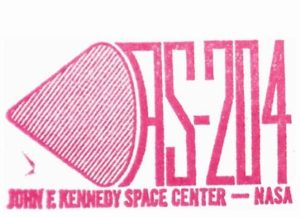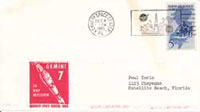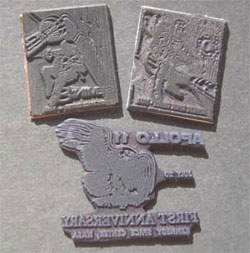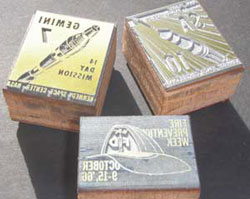David Ball discovered a rare envelope flown aboard the Space Shuttle Challenger—and returned it to its rightful owner over four decades later.

This is not your average piece of air mail. Created to celebrate the 25th anniversary of NASA, the small envelope left the Earth’s atmosphere aboard the Space Shuttle Challenger in 1983. As part of the cargo on the spacecraft’s STS-8 mission, the piece was one of only ten to be signed by all five members of the Challenger crew. Upon the shuttle’s return, five of the signed envelopes were presented to the President and Vice President of the United States, the Postmaster General, the Smithsonian Institution and the NASA Administrator. The other five were earmarked for the shuttle crew members themselves. But one of these envelopes was never received by its intended recipient—until it showed up on eBay, 38 years later.
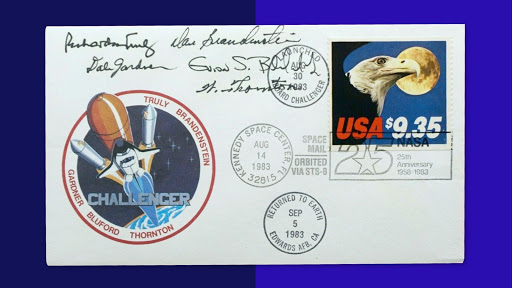
A lifelong stamp collector and author of American Astrophilately: The First 50 Years, David Ball is one of this country’s foremost experts on items like these: envelopes that can tell a story of space travel when postmarked near launchpads and mission control centers, and aboard recovery ships. When David saw the STS-8 envelope—or “cover,” in the parlance of philatelists—on eBay this past March, he was stunned. Five signatures were there, clear and visible on David’s computer screen. The postmarks were there, too, confirming the shuttle’s launch date from the Kennedy Space Center and its return to Earth one week later. Its listing on eBay, however, was a puzzle, and just the sort of challenge that David found captivating.
David was raised in Natick, Massachusetts, a bedroom community about 20 miles west of Boston. He started collecting stamps at the age of eight, when a tumble on his bicycle landed him in the hospital for two days. To keep him occupied, his mother bought him a stamp album. “She’d collected stamps when she was a young girl living in Trinidad,” David said. “Particularly for someone who’s introverted, collecting postage stamps is just a wonderful lifelong companion. She’s been supportive of my collecting activities for more than 50 years now.”
As a young boy, David enjoyed reading adventure stories about explorers, test pilots and astronauts. “I was born in 1959, so I was ten when they landed on the Moon,” he said. So it was natural that his stamp collecting interests might bend toward the stars.
In 1991, David was commissioned as a second lieutenant in the U.S. Air Force. Serving as a flight nurse for 26 years, he led medical teams transporting wounded soldiers, many in their teens, from war zones in Iraq and Afghanistan to hospitals in Germany and the U.S. All the while, he continued to avidly collect stamps.
Then in 2006, David traveled to the World Philatelic Exhibition in Washington, D.C., an international stamp show held in the U.S. once every ten years. While there, at a lecture about stratospheric balloon flights given by an esteemed Swiss collector, David learned about astrophilately. Astrophilatelists aren’t all that concerned about stamps with rockets on them, or about envelopes with pictures of astronauts, although that’s part of their field. For astrophilatelists, it’s all about tracking the history of the space program through postmarked envelopes connected to various launches and missions. “The combination of places and dates tells a story,” David said. “When you put a bunch of these envelopes together, you can show how stratospheric balloon flights made it possible for us to have Project Mercury, or how the X-15 made it possible for us to have the Space Shuttle. Astrophilately is really the intersection of space and postal history.”
A long-time collector of stamps and lover of the history of space travel, David discovered an entire world and realm of study where space travel was at its center, but the stamps played second fiddle. “The stamps are actually incidental,” he said. “It’s really all about the postmark.”
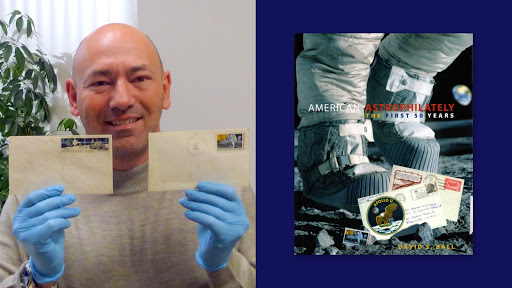
At left: David holding the Moon cover cancelled by the Apollo 11 crew on the way back from the first manned lunar landing. The other envelope was postmarked by Dave Scott of Apollo 15 on the surface of the Moon. At right: Cover of “American Astrophilately: The First Fifty Years,” published in 2010.
David was hooked. Astronauts, he soon learned, had been taking envelopes to the moon since the Apollo 11 mission in 1969. For NASA, these covers were a great way to build excitement for the space program. Over the years, hundreds of thousands of covers have been created, selling for anywhere from a dollar or two for the most common ones to $30,000 for a signed Neil Armstrong cover that’s been to the moon. The cover David saw last March was remarkable not only because of its rarity—on the back of the envelope was a small numeral “3,” denoting it was one of the original ten signed covers—but because of its initial listing price: $3.00.
The bids climbed quickly from that initial low figure, as other astrophilatelists learned of the rare find. A friend of David’s who had met Richard Truly, the astronaut and former U.S. Navy admiral who was Commander of the Challenger mission, thought the cover might belong to him. As luck would have it, David already knew the former astronaut. Earlier this year, the two had met online during a meeting of serious stamp collectors, when David, a first-time visitor to the group, spotted a familiar name among the gathering. “In the chat box I wrote, you know, your name is the same as a famous Navy test pilot,” David said. “And he wrote back and said, yeah, that’s me.”
So when the rare Challenger cover appeared on eBay only two months later, David reached out to Richard and asked if there was a chance the cover was his. It was. For some reason, after the mission, NASA sent out the covers but Richard never received his—ironically, since he was the lone stamp collector of the bunch. As the bids rose, Ball let the shuttle commander know that if he won the auction, he would sell the cover to him for whatever he paid for it.
In the end, David won the crew-signed cover with a bid of $1,801.76. He sent the envelope to Richard, restoring the cover to its rightful owner after all these years. “That’s a once in a lifetime thing,” David said. “I’ve never heard of one of these being offered, and I doubt I will ever see one again.”
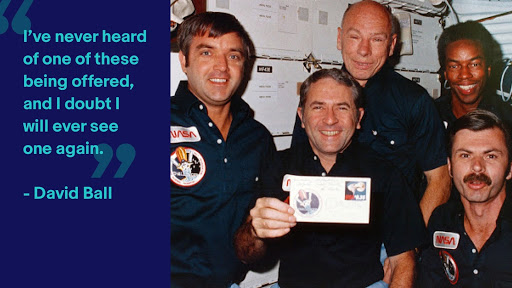
The crew of the STS-8 mission on the shuttle in 1983, with Richard Truly holding the stamp cover. Image credit: NASA
Not that David doesn’t have other treasures in his collection. He has a cover that was sent by a crew member of the Norge, an Italian-built blimp, which became the first aircraft to fly over the North Pole in 1926; and one from the Apollo 8 mission, the first to go to the moon, which he bought from a Navy corpsman who was aboard the USS Yorktown the day they fished the Apollo 8 astronauts out of the Pacific; and a cover from the Prime Recovery ship that picked up America’s first astronaut, Alan Shepard—which also started at an initial bid of $3 on eBay and ended at $1,400, since there are only 44 known still existing in the world. Just about every day, David is on eBay, searching for new finds. “It might be 3 a.m., and I’ll be looking for dog sled mail, or covers related to nuclear weapons,” he said. “I buy most of my postal history on eBay.”
Indeed, eBay has been an enormous asset for David, and others like him. “For the collector, and particularly for the specialist, it’s like the world’s biggest stamp show—but it’s indexed,” he said. “If you think about it, if I were to show up at a stamp show that was as big as eBay, I still couldn’t find what I was looking for. With eBay, you’ve not only taken me to the stamp show, you’ve also allowed me to run a computer search on the cover and told me to go to these three dealers. I’m even going to show you a picture of it. I mean, how wonderful is that? That’s a kid in a candy store.”




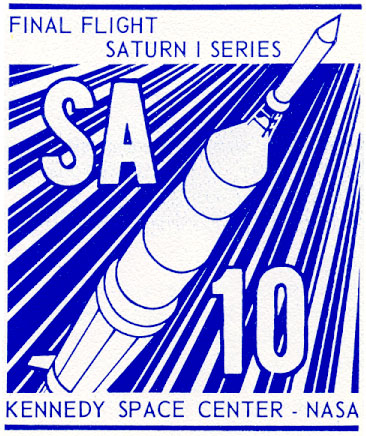
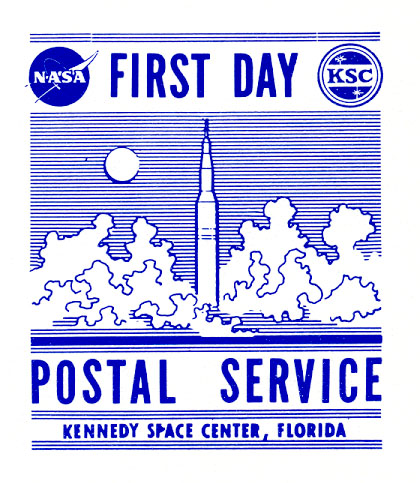
 Alternate colors are often seen in tandem with legitimate ONCs. When seen with Cape Canaveral hand cancels the postmark may be backdated. When colors appear in alternate sized artwork the cachet is commercial.
Alternate colors are often seen in tandem with legitimate ONCs. When seen with Cape Canaveral hand cancels the postmark may be backdated. When colors appear in alternate sized artwork the cachet is commercial.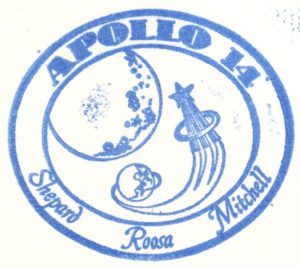
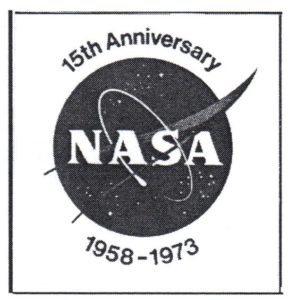 The fact that something printed was paid for or distributed by NASA does not make it an Official. Over the years a number of “etiquette” labels have surfaced. Two labels, Apollo 7 and 8 are rightly recognized as Officials. To be an ONC there must have a direct connection to the KSC post office. Similarly, rubber stamps donated by stamp dealers that were used on mail at the Visitor Information Center at the space center do not qualify under the author’s definition.
The fact that something printed was paid for or distributed by NASA does not make it an Official. Over the years a number of “etiquette” labels have surfaced. Two labels, Apollo 7 and 8 are rightly recognized as Officials. To be an ONC there must have a direct connection to the KSC post office. Similarly, rubber stamps donated by stamp dealers that were used on mail at the Visitor Information Center at the space center do not qualify under the author’s definition.